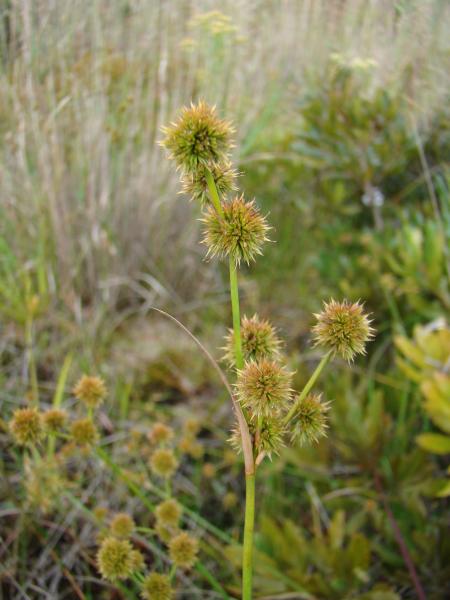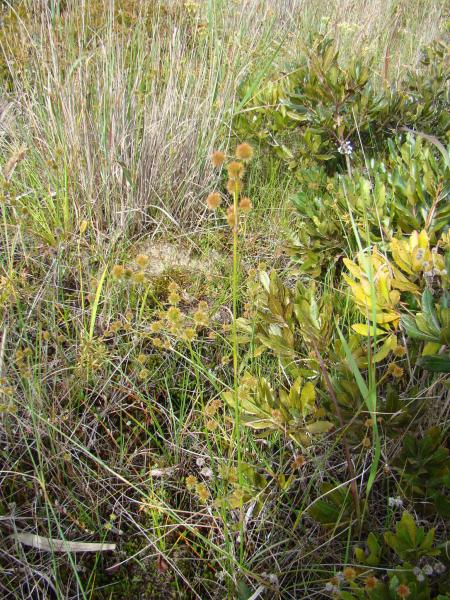Sedge Rush
Juncus scirpoides Lam.
- Class
- Monocotyledoneae (Monocots)
- Family
- Juncaceae (Rush Family)
- State Protection
- Endangered
Listed as Endangered by New York State: in imminent danger of extirpation in New York. For animals, taking, importation, transportation, or possession is prohibited, except under license or permit. For plants, removal or damage without the consent of the landowner is prohibited.
- Federal Protection
- Not Listed
- State Conservation Status Rank
- S1
Critically Imperiled in New York - Especially vulnerable to disappearing from New York due to extreme rarity or other factors; typically 5 or fewer populations or locations in New York, very few individuals, very restricted range, very few remaining acres (or miles of stream), and/or very steep declines.
- Global Conservation Status Rank
- G5
Secure globally - Common in the world; widespread and abundant (but may be rare in some parts of its range).
Summary
State Ranking Justification
There are six existing populations are and two of them have hundreds of plants. The other four are of unknown quality. There are about 20 historical occurrences.
Short-term Trends
The plant populations that have been resurveyed have stayed the same.
Long-term Trends
There has been a moderate decline in populations over the years as wetlands on western Long Island have been developed and Phragmites has become more common in coastal wetlands.
Conservation and Management
Threats
Some of the wetlands are threatened by nearby development and others are threatened by the encroachment of Phragmites into the wetlands.
Conservation Strategies and Management Practices
Protect the wetlands from Phragmites invasion and hydrologic changes from nearby developments.
Research Needs
Studies should be done to determine how severe the threat from Phragmites will become. We would also like to know if populations can be augmented.
Habitat
Habitat
In New York this species occurs in a marshy area of successional pine barrens and a grassy margin of a channelized stream. It also occurs in an abandoned pit within a post oak-blackjack oak barrens where the substrate is sandy and in maritime brackish interdunal swales in a large dune complex. (New York Natural Heritage Program 1998). Damp sandy soil, shallow pools, wet pinelands, etc. (Fernald 1970). Wet sandy soil, meadows, and shores (Gleason & Cronquist 1991).
Associated Ecological Communities
- Brackish interdunal swales
(guide)
Temporarily tidally flooded temperate marshes in interdunal swales dominated by salt-tolerant graminoids. Individual swales occur as small patches positioned between fore-, primary and secondary dunes in a maritime dunes system, typically on barrier islands.
- Maritime shrubland
(guide)
A shrubland community that occurs on dry seaside bluffs and headlands that are exposed to offshore winds and salt spray.
- Post oak-blackjack oak barrens
(guide)
Open barrens on upper slopes and low ridges characterized by the presence of stunted individuals of post oak, scarlet oak, and blackjack oak. There is a sparse heath and grass ground cover growing in very dry, deep, exposed sand overlying a clay subsoil.
- Sea level fen
(guide)
A wetland that occurs at the upper edge of salt marshes but is fed primarily by acidic groundwater seeping out along the upland edge. This fresh water sometimes mixes with salt or brackish water during unusually high tides. There is a high abundance of sedges that decompose slowly and create a deep substrate of peat. This peat is underlain by deep sand or gravel. These fens usually have a high diversity of herbs but may also have scattered trees and shrubs.
Associated Species
- Carex
- Carex silicea (beach sedge)
- Diodia teres (rough buttonweed)
- Drosera filiformis (thread-leaved sundew)
- Drosera intermedia (spatulate-leaved sundew)
- Eupatorium perfoliatum (boneset)
- Eupatorium torreyanum (Torrey's thoroughwort)
- Juncus gerardii
- Lespedeza repens (creeping bush-clover)
- Lespedeza virginica (slender bush-clover)
- Limonium carolinianum (sea-lavender)
- Lycopodiella appressa (appressed-leaved bog-clubmoss, swamp bog-clubmoss)
- Phragmites australis (old world reed grass, old world phragmites)
- Pinus rigida (pitch pine)
- Plantago juncoides
- Pycnanthemum verticillatum
- Sabatia angularis (bitter-bloom, rose-pink)
- Sabatia stellaris (sea-pink)
- Scirpus cyperinus (common wool-grass)
- Smilax
- Solidago sempervirens (northern seaside goldenrod)
- Spartina alterniflora (smooth cord grass)
- Suaeda
Range
New York State Distribution
There are known locations from Queens and Suffolk counties on Long Island and also from Staten Island with historical locations in the Bronx and Nassau County. There are reports from Otsego County and from the salt marshes of Onondaga County which are considered extirpated.
Global Distribution
This rush is distributed in the Atlantic coastal states from Rhode Island south to Florida. It is also common in the southeastern and central US from Kentucky and Illinois west to eastern Texas, Oklahoma and central Kansas. It is rare in its northern limits from New York and Pennsylvania to Michigan, Indiana, Illinois, and Nebraska.
Identification Comments
General Description
This rush has stems that are erect and 4-9 dm tall. The rhizomes are tuberous. The leaves are terete with cross partitions and they are not longer than the inflorescence. The leaf sheaths are smooth and not ribbed. The flowers are in rounded clusters and pale green to dull brown, without subtending bracteoles. There are 3 stamens and the tepals are long and narrow at the tip (subulate). The capsules are long and narrow, stick out from the tepals and the valves stick together at the top. The seeds are light brown and not tailed.
Identifying Characteristics
Distinguishing characteristics: stems erect, 2.5-9 dm tall; thick horizontal whitish rhizome; leaves terete, conspicuously septate; few or many densely flowered pale green to dull brown spherical heads, much longer than the involucral leaf; sepals and petals rigid, bristly-pointed, at length pungent; anthers exserted; capsule subulate, 5 times as long as thick, equaling or usually slightly surpassing the tepal, dehiscent in the basal 2/3. Best life stage for ID: in fruit. Characteristics needed to ID: culms with leaves and mature achenes.
Best Life Stage for Proper Identification
The best time to identify this rush is when it is in fruit.
Similar Species
Another Long Island rush, Juncus brachycarpus, short-fruit rush, has ovoid capsules that are shorter than the tepals and the valves do not stick together at the top after it opens.
Best Time to See
The fruits are visible from July through early November.
- Fruiting
The time of year you would expect to find Sedge Rush fruiting in New York.
Sedge Rush Images
Taxonomy
Sedge Rush
Juncus scirpoides Lam.
- Kingdom Plantae
- Phylum Anthophyta
- Class Monocotyledoneae
(Monocots)
- Order Juncales
- Family Juncaceae (Rush Family)
- Order Juncales
- Class Monocotyledoneae
(Monocots)
- Phylum Anthophyta
Additional Common Names
- Sedge-rush
Synonyms
- Juncus polycephalus var. crassifolius Torrey
- Juncus polycephalus var. tenuifolius Michx.
- Juncus scirpoides var. compositus Harper
- Juncus scirpoides var. genuinus Buch.
- Juncus scirpoides var. meridionalis Buchenau
- Juncus scirpoides var. scirpoides
Additional Resources
Best Identification Reference
Flora of North America Editorial Committee. 2000. Flora of North America north of Mexico. Vol. 22. Magnoliophyta: Alismatidae, Arecidae, Commelinidae (in part), and Zingiberidae. Oxford Univ. Press, New York. xxiii + 352 pp.
Other References
Clemants, Steven E. 1990. Juncaceae (rush family) of New York State. Contributions to a flora of New York State VII Richard S. Mitchell, ed. New York State Museum Bulletin No. 475. 67 pp.
Fernald, M.L. 1950. Gray's manual of botany. 8th edition. D. Van Nostrand, New York. 1632 pp.
Gleason, Henry A. and A. Cronquist. 1991. Manual of Vascular Plants of Northeastern United States and Adjacent Canada. The New York Botanical Garden, Bronx, New York. 910 pp.
Holmgren, Noel. 1998. The Illustrated Companion to Gleason and Cronquist's Manual. Illustrations of the Vascular Plants of Northeastern United States and Adjacent Canada. The New York Botanical Garden, Bronx, New York.
Mitchell, Richard S. and Gordon C. Tucker. 1997. Revised Checklist of New York State Plants. Contributions to a Flora of New York State. Checklist IV. Bulletin No. 490. New York State Museum. Albany, NY. 400 pp.
New York Natural Heritage Program. 2024. New York Natural Heritage Program Databases. Albany, NY.
Reschke, Carol. 1990. Ecological communities of New York State. New York Natural Heritage Program, New York State Department of Environmental Conservation. Latham, NY. 96 pp. plus xi.
Weldy, T. and D. Werier. 2010. New York flora atlas. [S.M. Landry, K.N. Campbell, and L.D. Mabe (original application development), Florida Center for Community Design and Research http://www.fccdr.usf.edu/. University of South Florida http://www.usf.edu/]. New York Flora Association http://newyork.plantatlas.usf.edu/, Albany, New York
Links
About This Guide
This guide was authored by: Stephen M. Young
Information for this guide was last updated on: September 6, 2012
Please cite this page as:
New York Natural Heritage Program. 2024.
Online Conservation Guide for
Juncus scirpoides.
Available from: https://guides.nynhp.org/sedge-rush/.
Accessed July 26, 2024.

